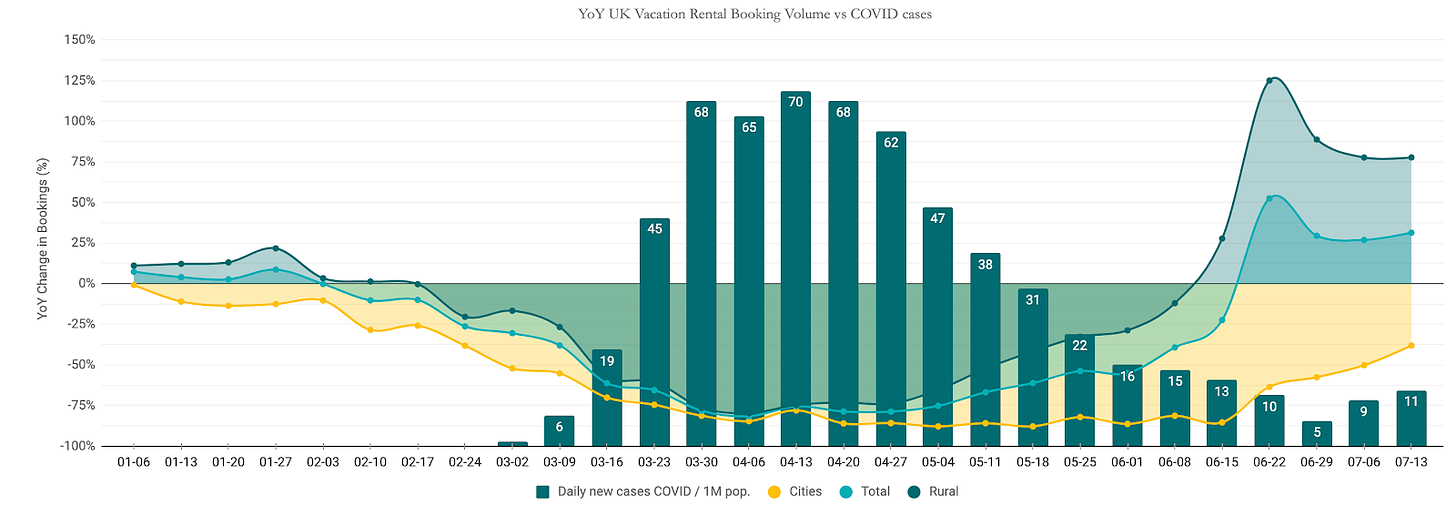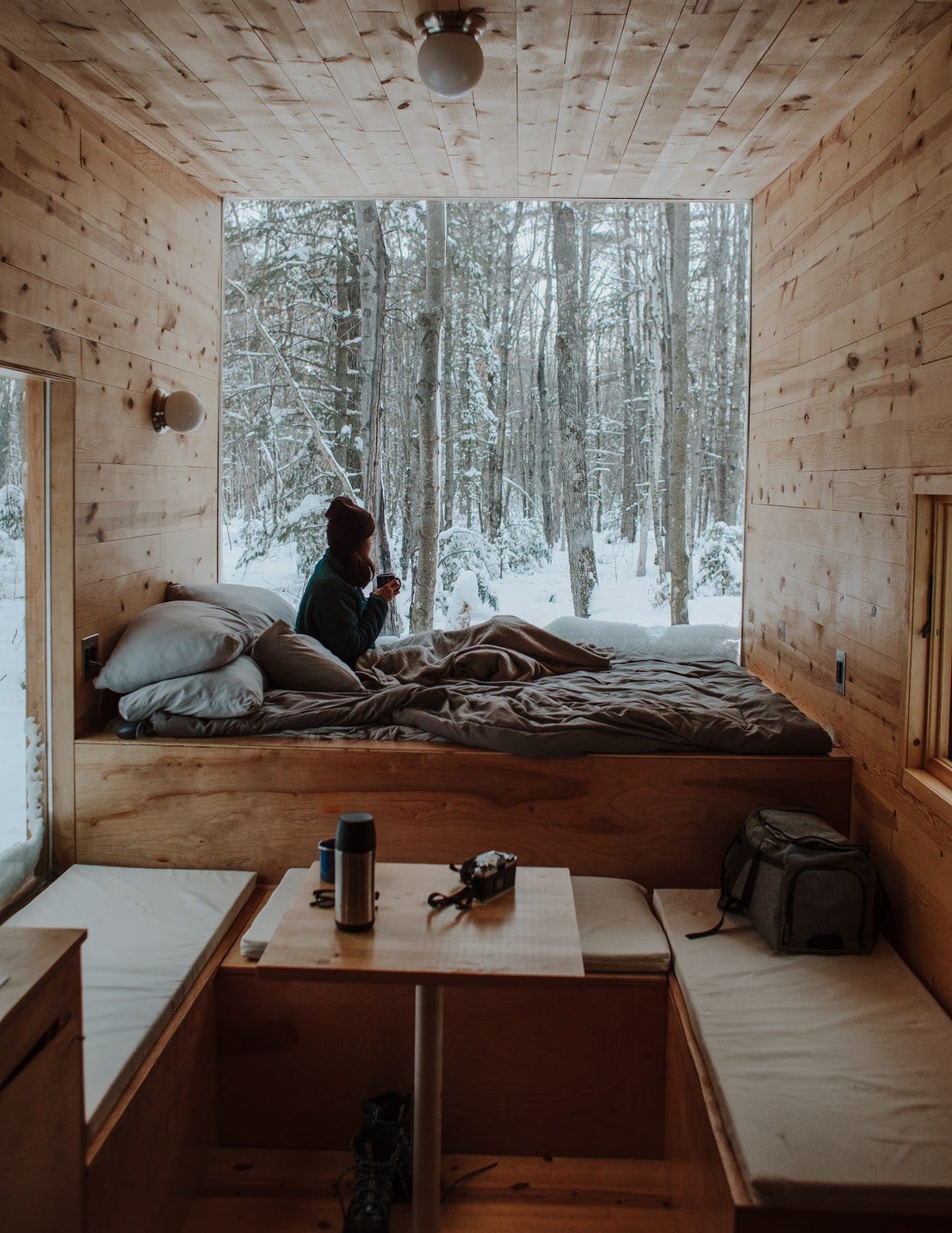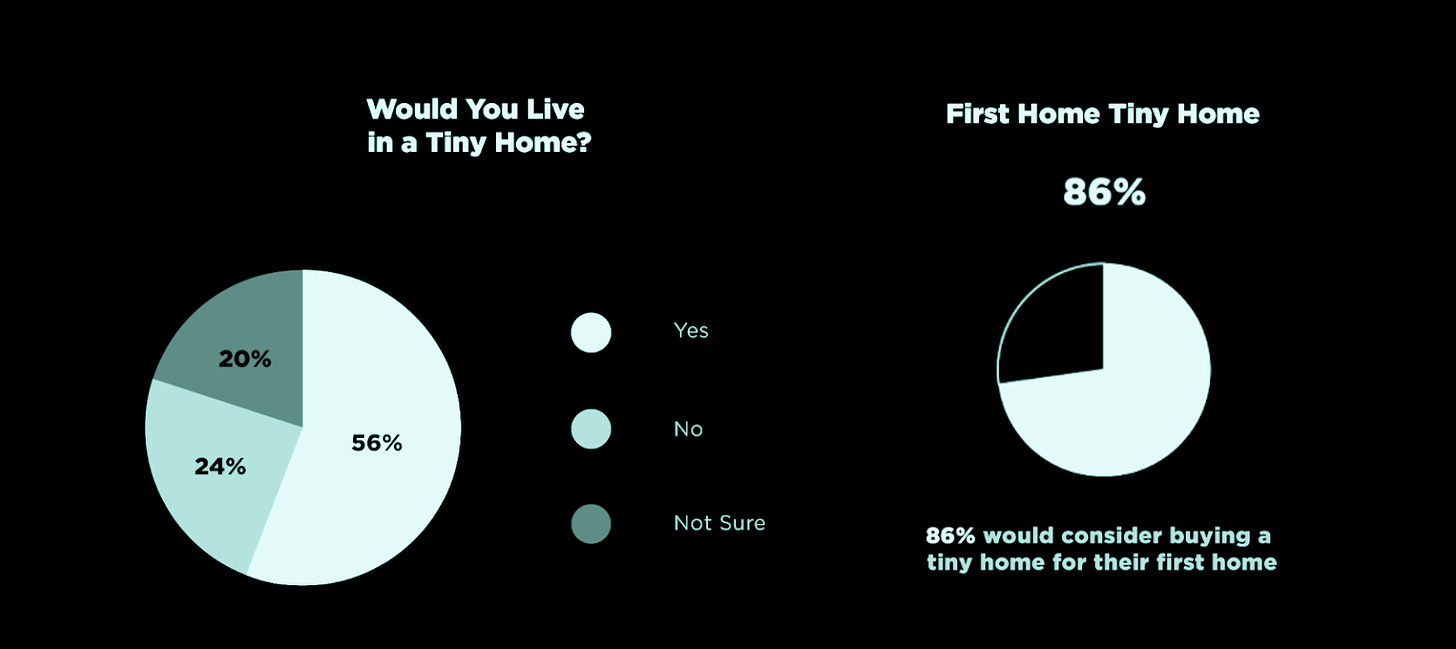Let’s talk about a few pandemic revelations
A LOT of things have changed over the course of 2020/2021.
Apart from everyone and their dog learning how to make bread, this dumpster fire of a year (will it ever end??) has given us the chance to take a hard, critical look at the system’s inner workings and see who it’s actually designed to benefit (hint: it sure as hell isn’t the people who keep it running).
For one, we’ve realized that it’s totally possible to work from anywhere and most of the time we put into work in the first place? Not even necessary.
Two, it seems like the entire world just realized that nature…actually…exists???
If you want to see where these two *profound* collective realizations are going, all you have to do is take a look at Airbnb’s data.
The company’s rural bookings surged last summer with rural hosts earning over $200 million in June 2020 alone. That’s a 25% increase from 2019, meaning that 9 out of every 10 dollars earned by US Airbnb hosts that month came from bookings made outside of the 10 biggest US cities. And this isn’t just a US thing, it seems to be a worldwide, year-round trend:
“9 out of 10 dollars earned by US Airbnb hosts came from outside top 10 biggest US cities”
UK Vacation Rental Booking Volume. Not bad eh?

In previous newsletters, we’ve already talked about turning dirt into dollars, the future of construction and as always, valuing money for what it’s really worth.
But, let me ask you a question. What happens when you combine sky high urban real estate prices with the ability to work from anywhere and an intense need to “bEcOmE oNE wItH nAtUrE”?
A Tiny House BOOM
Did anyone else hear that?
For the Contrarians who haven’t seen these things yet, they’re exactly what they sound like: tiny homes, shrunk to meet your basic needs + a little more if you want. As an added bonus they have ultra-low utility consumption, take about 6 months to build starting as low as $10K and going as high as $150K for luxury models, and can be moved.
Now tiny houses aren’t just a passing fad or temporary honey-I-shrunk-the-kids scenario. Why can I say that with confidence? Because tiny houses are actually a movement, a pretty old one too that’s quietly been gaining steam over the years. More importantly, it’s a movement that isn’t just about affordable real estate, it’s about a shifting attitude towards a new modern-day lifestyle. It’s also been given a major boost by pandemic revelations. I don’t want to live in one, but I’d sure as hell rent one.
According to a nation-wide survey on tiny houses, more than half of Americans would be open to living in one and 86% would consider buying one. Honestly, this shouldn’t be a surprise considering the ridiculous cost of an average home, which hit its highest point in U.S. history in 2020.
Source: IPX1031
But in true Contrarian fashion, I hate to see any part of an opportunity go to waste. So why stop at just tiny house living (or why start – I don’t love anyone enough to live in that close of proximity), when you can turn investments in tiny homes into big returns?
Or so they say… let’s see if they’re right.
Tiny Houses, Big Gains
Apparently, tiny houses make rather intriguing investments when they’re operated as a recreation property or monthly rental. They’re eco-friendly, efficient, affordable, mobile, and as of late, very in demand. So here’s the rundown of tiny houses, the business of them, and the opportunity they hold for people who want to turn the tables and start making their money work for them. IF you do it right.
Now we’re ahead of the game here in this market, tiny homes still compromise a minuscule percentage of homes, rentals, or communities, which is good. But that also means that there isn’t as much direction out there. So we harassed Rob (aka Robuilt on the Youtubes). Don’t let the backward hat fool ya, he’s on to something here.
Turns out Rob didn’t even know much about tiny houses. But in a couple of years, he’s gone from building one tiny house to managing 10 tiny house rentals REMOTELY, to 72k Youtube Subscribers, to his most recent venture of building a tiny house community on 50, dare I say rather pristine, acres of Tennessee land.
He might blame it on his ADHD, but this guy lives and breathes tiny houses.
Here’s the breakdown of what you’ll need to consider when starting a tiny house Airbnb operation…
Spoiler – I’m totally going to try this and steal his playbook for my new Airbnb rental. I’ll share later.
#1: Buying or Building?
Each comes with its own pros and cons so let’s take a look at the key considerations for both
Location! Location! Location!
This applies to buying and building but choose your plot-a-land carefully. Search other Airbnb listings, see which areas are most popular for activities like camping, and know the zoning of the land. Zillow is a great resource for this. Check their listings for undeveloped land and, usually, since tiny houses can (often) be considered a mobile vehicle if you stick a pair of wheels on them, anything that’s OK for an RV is OK for a mobile tiny house. Many tiny houses are also built as Attached Dwelling Units (ADUs) on land that already has a main building on them. This is also an option if you can’t afford to buy new land.
Financing
Tiny houses cost just a fraction of regular homes, currently sitting at $59,884 on average. Unfortunately, this also means that you can’t generally get a mortgage on them for a variety of reasons. What you can do, however, is get a loan. And there are two specific types that you could be eligible for if you’re going for a tiny house on wheels: a recreational vehicle loan or a travel trailer loan. Interest rates for these loans are usually between 6 – 19% on 15-year terms.
If you’re going for a tiny house that’s on a foundation, personal loans or a line of credit are also an option (note that interest will be tax-deductible if you plan to continue owning a traditional house).
My personal favorite, cash-out refinancing. This is a potentially smart option that allows you to replace your current mortgage with a new, larger one. The difference between the two values can be taken out as cash to make any upgrades to your home, or I don’t know? Invest in a tiny house perhaps?
Basic Building Costs:
Now building a tiny home is a whole other beast than buying, but stay with me here, it’s not as bad as it looks once you get past the regulations.
Rob’s gone through the ordeal himself, so we’ve got the advantage of learning from his mistakes and successes. I always like other people to lose money first and then I come in and learn from them:
- You’ll need to hire a draftsperson or an architect. A draftsperson will usually charge between $1.75 – $2.50/ft². They’re cheaper than hiring an architect but possibly at the expense of design. Hot tip: make sure your draftsperson or architect is aware of your state/city’s prescriptive code. If your design adheres to it you could save a good $2,500 on engineering fees later on.
- There are a few tests and reports you need as soon as you secure your land: percolation tests to determine septic tank design ($2200), a soil report ($3,000) which can usually be bypassed if your draftsperson/architect follows prescriptive code
- Site plans ($100)
- A Will Serve Letter to your water department
- While you’re at it, see if you have an active water meter on site. If not, you’ll have to dish out anywhere from $6,000 to ~$21,000 to activate or install one.
- Fire flow test ($80) to the nearest fire hydrant (may differ by state but in California, all new constructions require a sprinkler system ($3,500- $4,500).
- Grading plan (this is only necessary if you’re a fan of hills and need to move over 50 yd of dirt around in the site to level things out. Not usually something to worry about with tiny houses.
- A construction waste disposal plan ($150).
- Plan check. Submit your plans to the city for approval. Some may have online portals, but if you’re living in the stone age like some city departments are you’ll have to submit hard copies. After they’ve been reviewed you’ll likely have to send your architect/draftsperson back to the drawing board one last time to make suggested or required changes before getting your building permit approved. Permits vary in cost depending on your square footage ($1,000 – $2,000).
- Finally, you’ll likely have to pay school fees which vary depending on the area but usually range from $1,000 to $3,000
Still with me? Good, that’s the hardest part which will cost you about ~$22,480 (on the high end) just to start building. The construction itself is usually another $12,000 to $35,000. This breakdown was useful:
#2: Pricing and operating your listing
If you’ve read my previous piece on buying land for $10k and making $1,500 a month on it, the rest of these sections will seem familiar BUT with a few important twists to make it work for our tiny house dreams.
Pricing your Airbnb:
- With most of his listings, Rob’s booked almost 100% of the year, which usually means your prices are too low.
- Pro tip: Up your prices when demand is high during the summer months and on the weekends throughout the year.
- Play around with your minimum stay lengths: monthly vs. two/three day minimum vs. variable. See what works for you and your listing. Or use pricing tools.
Consider Your Monthly Costs:
- Rob’s chalked it up to a few key ones, and others you might also want to consider:
- $25: house supplies (toilet paper, shampoo/conditioner, etc)
- $50: insurance
- $50: utilities
- $120: cleaning fees (these can also be passed on to guests)
- $800: loan (monthly loan payments vary)
- $100: pest control
- $60: internet
- $40: trash_________________
- Grand Total: $1,245
And how much does Rob end up pulling in from his guests each month? Depends on the listing, location, and time of year.
But on average he brings in $4243 in the Fall and $3915 at the peak of Summer. Even with the maximum costs applied, these would mean profits of at least ~$2,834 a month to pay off your mortgage/loans and have extra leftover.
I like this video on it —>
#3: Have some boots on the ground
Ever heard of Murphy’s Law?
Be optimistic, but always be prepared for things to take a turn for the worst – leaky roof, broken amenity, upset guests, anything can happen and will happen.
To help you deal with things when shit hits the fan, you’ll need to hire a few people and you’ll need to pay them well, especially if you plan to operate your rental remotely and want people you can trust:
- Cleaning Services
- Handyperson
- Contractor
- Realtor
- Landscaper
Your Cleaners are like your eyes and ears of the operation. They’ll know if and what is damaged, which supplies are about to run out, and if the guests are going to cause any trouble or need any help. As Rob puts it, they’re probably the most important part of your tiny house hustle. Handypeople and Contractors are good to have on hand for emergency fixes and routine checkups alike. Depending on your tiny house design, a landscaper might also be needed to keep things looking trim. This is also where your Realtor comes in — the second most important person you’ll need because of the local connections you have. You think a good contractor or plumber is going to show up out of nowhere?
NOPE.
Your Realtor is the one who’ll know who’s who and get you connected. Treat them well. And if you can find someone who can kill two birds with one stone, even better. Hire em’.
#4: Automate as much as you can
There are a number of programs out there that’ll make your life (and the lives of the people you hire) a LOT easier.
- Give your cleaners access to your Airbnb activity through a program like Your Porter, which automatically sends them a message every time a booking is made so they can prep ahead of time and know what to expect without constantly having to communicate/wait on you.
- Struggling with pricing and/or sick of manually changing it to reflect higher weekend and holiday rates? Beyond Pricing automates listing prices for hosts depending on holidays, seasonality, day of the week, and the base pay you set your rental to.
I like leverage.
If you’re intrigued and want to learn more:
Subscribe to Rob’s Youtube channel – Robuilt- to see how he went from 0 to 1 in two short years and have a good laugh while you’re at it.
Tiny homes. Who knew they could have such a big ROI.
Eh, and if the apocalypse happens. You got an off-the-grid home base. Aint’ a bad idea.
Until then,
Question everything and buy smarter,







